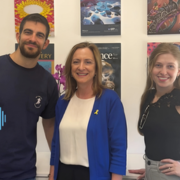Prof. Nidal Muhanna elected to international CORLAS
Congratulations
Prof. Nidal Muhanna, MD-PhD, Chair of the Department of Otolaryngology Head & Neck Surgery and Maxillofacial Surgery at the Tel Aviv Sourasky Medical Center (TASMC) and Associate Professor at the School of Medicine, Faculty of Medical and Health Sciences at Tel Aviv University, was recently elected to the international Collegium Oto-Rhino-Laryngologicum Amicitiae Sacrum (CORLAS).
The Collegium is an international association that elects its members. One must have accomplished excellence in ENT research and be under the age of 50 to be nominated. The limit is 10 per country - 7 MDs and up to 3 PhDs. Prof. Muhanna is joining the Israeli chapter, with current members Prof. Karen Avraham (head of the Israeli chapter and recent awardee of the CORLAS Shambaugh Prize for Excellence in Otology Research), Prof. Michal Luntz, Prof. Ronen Perez, Prof. Lila Migirov, Prof. Ronna Hertzano, Dr. Yona Vaisbuch, Dr. Arkadi Yakirevitch and new member Dr. Chanan Shaul. Honorary members include Prof Jona Kronenberg, Prof Haim Sohmer, Prof Josef Elidan, Prof Hillel Pratt and Prof Raphael Feinmesser.
Prof. Muhanna graduated from the Hebrew University of Jerusalem with an MD in 2003. He pursued a PhD on the Immune-Modulation of the Liver Fibrosis, awarded in 2013 from Hebrew University. He performed his residency in Otolaryngology at the Shaare Zedek Medical Center and a fellowship in Head and Neck Surgical Oncology & Reconstruction at the Princess Margaret Cancer Centre, University of Toronto, Ontario, Canada. In 2020 he became the chair of the Department of Otolaryngology Head & Neck Surgery and Maxillofacial Surgery and Director of the Interdisciplinary Center for Head & Neck Surgical Oncology at the TASMC. He is a member of the American Academy of Otolaryngology—Head and Neck Surgery.
Prof. Muhanna’s research focuses on developing innovative therapeutic approaches and diagnostic methods to address the challenges encountered in the clinical treatment of head and neck cancer. His work integrates advanced technology platforms, such as molecular imaging, novel nanoparticles, and robotics, into therapeutic strategies. The primary objectives of his research are the clinical translation of these cutting-edge guidance and therapeutic technologies. This includes designing novel molecular tools to detect circulating cancer DNA and cancer cells in blood and saliva samples, as well as exploring the use of new imaging agents during head and neck surgeries to identify tumors and metastatic disease.





